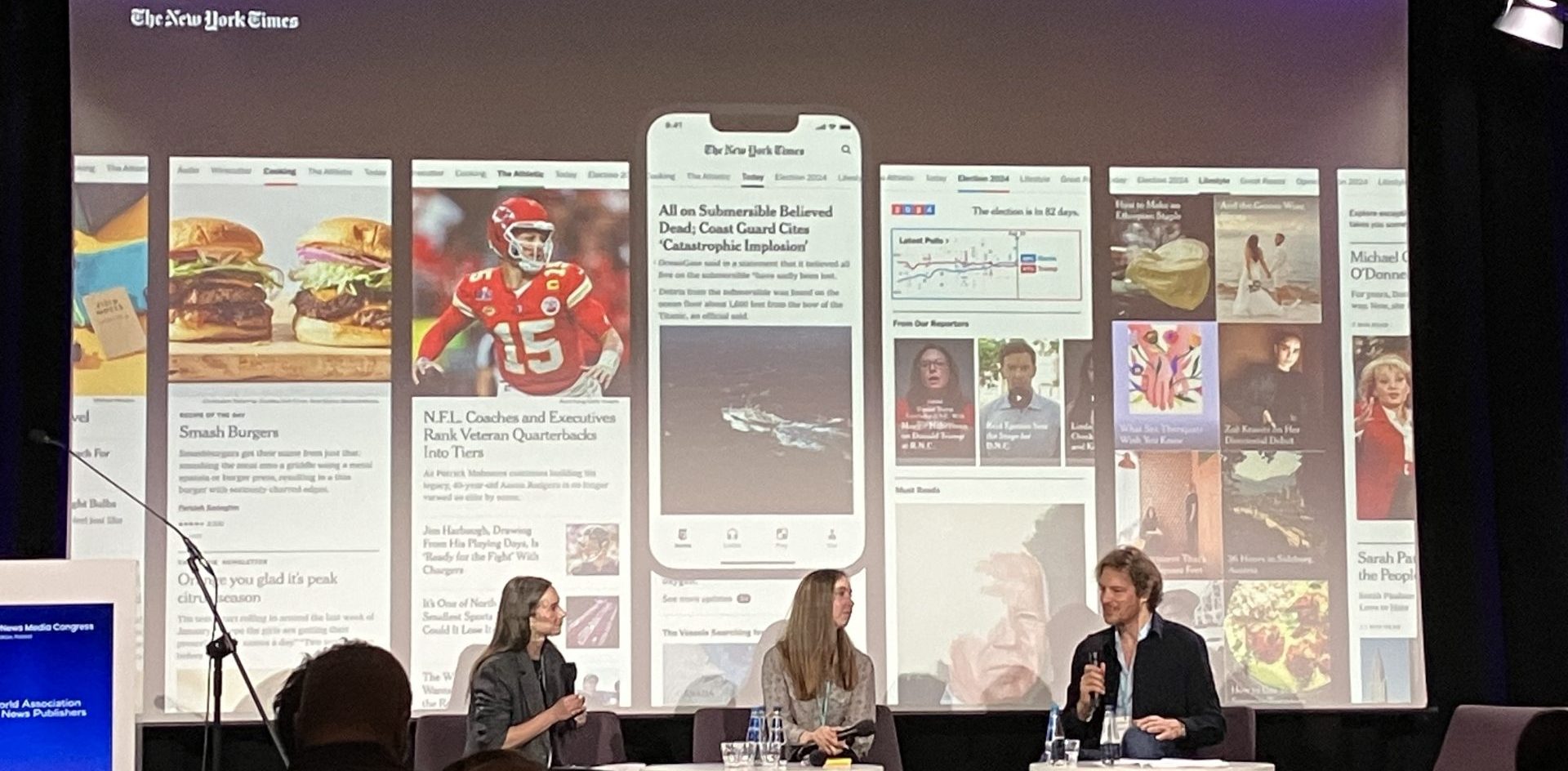
Newsletter
Newsletter
Publishers from around the world talked about the tactics they are using to increase the acquisition and retention of audiences and to create new products.
8th March 2024

In the Pugpig weekly media bulletin, Pugpig’s consulting services director Kevin Anderson and digital growth consultant James Kember distill some of the best strategies and tactics that are driving growth in audiences, revenue and innovation at media businesses around the world.
If you want to know more about how we are working with publishers like you, get in touch at info@pugpig.com.
Last week INMA hosted their Media Subscriptions Summit in New York. The week-long event aimed to address “the strategic challenges faced by publishers in the era of AI disruption, accelerating digital transformation, and deep political and societal changes.”
At the conference:
Three major themes emerged from the conference: testing, audience strategy and new product development. In this week’s Pugig Media Bulletin, we will take a deeper look at these themes.
In one session, Mio Kataoka, product manager at Nikkei took the summit through the Japanese newspaper’s latest approach to digital conversion. Mio detailed the simple segmentation they had applied to the marketing funnel, sorting users into 25 million unregistered, 5 million registered and 900k paid subscribers. Once they understood the size of the opportunity, they took a simple, but meticulous, approach to reach their target audience of urbanised white-collar workers. They tested a huge number of CTAs across the web and the app.
Nikkei’s starting point was to identify all the hypotheses they had developed within the organisation and to design a comprehensive testing strategy to scrutinise them all. This enabled them to carry out a range of A/B and multivariate experiments to understand what messaging to deploy throughout the conversion funnel. The outcome of this was a significant improvement in both their conversion rate and their strategic efficiency.
American journalists love to display their professional scepticism by saying if your mother says she loves you, get a second source (or some variation on a theme*). We believe publishers should apply this same level of scrutiny to their business assumptions. In our conversations with publishers, we always advocate for using testing as a way to prove, or disprove, these assumptions. We always start by ensuring that the conversion journey works for the general audience before attempting to design cohort-based journeys, and it’s important to remember that there will always be users that you can’t place in a bucket.
The strategy taken by Nikkei is one that we advocate at Pugpig Consulting. Nikkei’s team focused on building an optimal digital journey with reasonably light user segmentation.
Last summer we explored the Washington Post’s three-step approach to subscriber engagement, where they built user segments based on the users’ level of activity. They identified six groups, ranging from no engagement to super highly engaged. This allowed them to identify users at risk of churning and to deploy messages to encourage them to adopt features they may not have been aware of.
The Washington Post is well positioned to take advantage of interest in the US presidential election this year, and their Global Head of Lifecycle Marketing, Anjali Iyer explained to the INMA summit how their new segmentation strategy had built upon the approach we discussed last summer. For Anjali, segmentation is “the basic foundation of loyalty and retention” and the Post’s approach looked to group users by their overall interest in politics as well as their level of engagement. Doing this, they formed three audience groups: “politics when it matters”, “engaged citizens” and “political enthusiasts”. This allowed them to align interests with engagement and match this to the in-depth political reporting they produce They also enhanced their personalised messaging and are looking to use automation to serve dynamic experiences.
Through this approach, the Post increased site retention and new user acquisition by 20%. Integrating acquisition and retention activities is key to their success, which, in the past, were frequently handled by separate teams. Therefore, another key topic of conversation that regularly popped up at the INMA summit was the need to remove organisational silos to deliver an optimal customer experience.
Meanwhile, the Wall Street Journal has been on a similar journey to better understand its audience. In a session that “underlined the shift toward an audience-first approach”, Dow Jones’ Chief Marketing Officer Sherry Weiss explained that although the WSJ’s core audience was business and finance professionals, they had started to think about their audience more broadly to serve more of their needs.
“When you base your audience on industry interest alone, you limit your reach and potential for growth”, Weiss said. Therefore, the WSJ embarked on an audience survey to better understand their audiences’ interests and to identify the content that is relevant to them. Importantly, they already had the content to appeal more broadly to their users, but their old audience strategy held them back because it was focused on firmographics, data of what companies or organisations where their readers worked. By moving away from this approach, they were able to adopt a user needs-based approach to their targeting. Weiss’ initial findings have been encouraging: They’ve increased their target audience by 10x.
For both The Washington Post and The Wall Street Journey, what is clear is that they have seen the value of an audience strategy that focuses on what the user wants, rather than what the title has traditionally offered. It hasn’t meant a revamp of their content offering, but instead, they’ve leant into what they’ve always done well, producing high-quality content. However, now, they have a broader idea of their audience’s interests and engagement and can market more effectively to serve a wider range of their needs.
These new ways of thinking about the audience have also enabled some publishers to broaden their product offerings. Handelsblatt’s Chief Marketing Officer, Wiebke Meeder, had been observing a decline in the performance of their paywall over time, which Wiebke put down in part to increasing news avoidance. To combat this, Handelsblatt developed a new type of product which used live content and was designed as “a mixture between an event business plus a membership model”. They targeted this to high-profile female thought leaders, offering passes to exclusive events and member-only newsletters. Whilst this aligned with their goal of “celebrating differences”, they needed a solid audience strategy to deliver it, which went beyond the traditional publisher/reader model. Although they received some negative feedback, the positives have outweighed the negatives.
Other publishers at the summit had also looked to develop their existing content to build new product lines. Norwegian publisher Schibsted explained that as a large publisher with multiple titles, they found themselves in a strong position to bring together previously isolated products into comprehensive bundles. The idea was that these new bundles allowed the publisher to offer a broader range of content to a more diverse audience. Moreover, they took a dynamic approach, whereby the user is given more control to select the content they want to include. This innovative approach was mirrored by Swedish media giant Bonnier, who leveraged their 50+ brands to offer the reader a huge selection of possible products within their subscription bundle.
From our work at Pugpig Consulting, we see huge improvements in engagement when the user is offered the option to select the content they’re interested in. Moreover, showing relevant messaging at the point of purchase works to increase conversion, just look at the Washington Post and the Wall Street Journal. Ultimately, the approach of a dynamic bundle is to bring those concepts together, and it can be an innovative way of increasing ARPU with existing content.
The key takeaway from the INMA summit was the importance of establishing a robust audience strategy connected to every aspect of the conversion journey and retention efforts. Everything a publisher does should align with this strategy, be it conversion or retention messaging, offers, bundling or new product development. Moreover, established publishers have a huge amount of data they can use to inform their strategy and a huge trove of existing content that can be combined in novel ways to serve audiences better.
* As a special bonus for scrolling to the bottom of the newsletter, we go into the history of the phrase about asking for a second source to confirm your mother’s love. There are many variations of the quote, and the most common is that if your mother says she loves you, check it out. It has been attributed to the venerable City News Bureau of Chicago, a local news service in the Windy City. Susy Schultz, who used to work at the bureau, said that research attributes the quote to “crusty”, hard-driving editor Edward H. Eulenberg. And the real quote is: “If your mother tells you she loves you, kick her smartly in the shins and make her prove it.”
Here are some of the most important headlines about the business of news and publishing as well as strategies and tactics in product management, analytics and audience engagement.

Newsletter

Newsletter

Newsletter

Newsletter

Newsletter